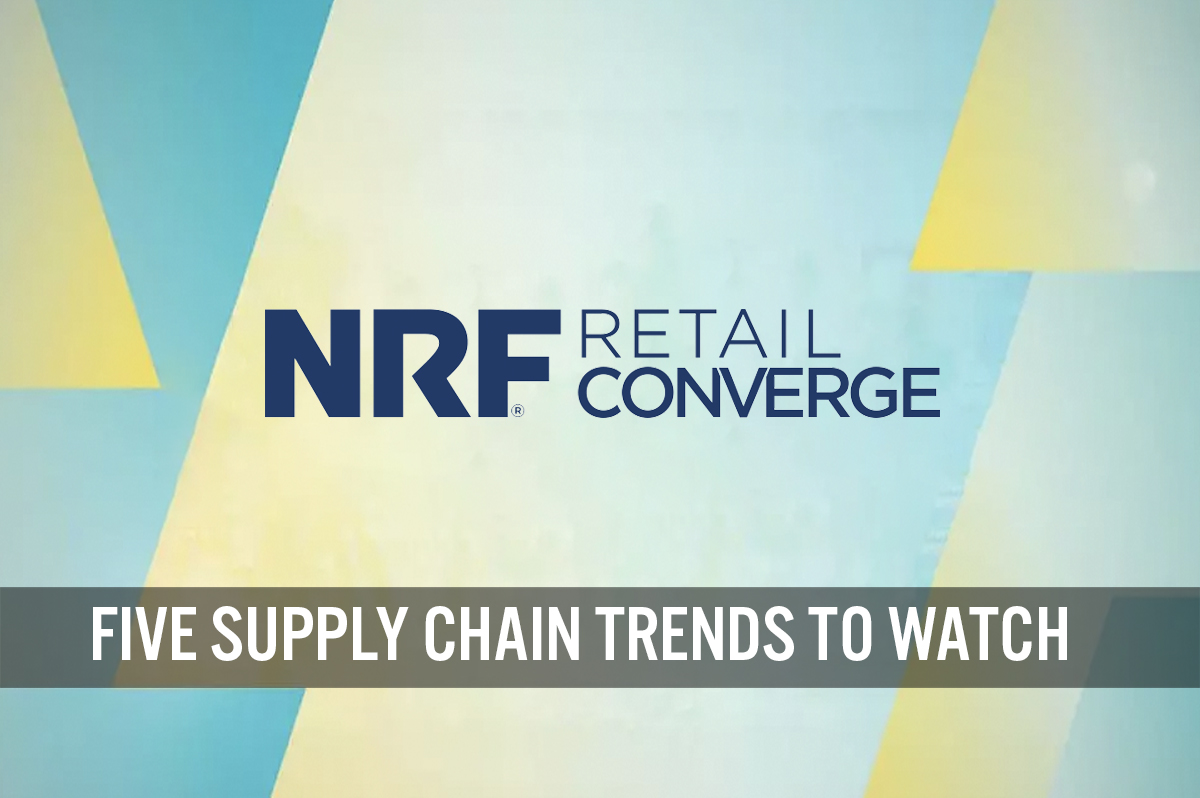
DIpil Das
On June 25, 2021, Deborah Weinswig, CEO and Founder of Coresight Research, hosted a session on retail supply chain trends at NRF Retail Converge, a new digital event from the National Retail Federation (NRF). She was joined by Colin Browne, COO of Under Armour, and Sarah Clarke, Chief Supply Chain Officer at PVH Corp.
We present five key insights from the event.
 Deborah Weinswig, Colin Browne and Sarah Clarke discuss the interconnectivity of ESG and profitability
Deborah Weinswig, Colin Browne and Sarah Clarke discuss the interconnectivity of ESG and profitability
Source: NRF [/caption] 2. Further Cost-Saving Supply Chain Opportunities Exist Outside Manufacturing
NRF Retail Converge 2021: Five Supply Chain Trends To Watch
The Covid-19 pandemic has given rise to much supply chain disruption in retail, compounding existing challenges around data sharing within retailers’ teams and with suppliers. It is therefore of heightened importance that retailers be cognizant of supply chain shifts and trends to enable them to realize cost-savings and other benefits in the short term, as well as to optimize operations for the future. “Apart from redesigning plans, companies are also valuing technologies to further digitalize their supply chain… There are truly numerous digitalization opportunities that companies could leverage when they are overhauling and futureproofing their plans,” Weinswig said. 1. ESG Objectives and Speed, Agility and Profitability Goals Are Increasingly Intertwined Returns are an ongoing retail challenge and managing reverse logistics amid the pandemic-induced spike in e-commerce is putting increasing pressure on brands and retailers. Clarke noted that strong reverse logistics to handle increasing customer returns are now a crucial part of the supply chain, and businesses need to assess how to make them affordable or even profitable. However, the financial implications of returns must also be balanced against ESG (environmental, social and governmental) considerations. Clarke and Browne discussed how ESG, speed, agility and profitability are becoming more interconnected and can no longer be mutually exclusive goals. Browne added that rethinking how a product is designed and produced with circularity in mind is continuing to gain prominence, in large part due to heightened consumer awareness of the impacts of their shopping decisions. Targeted manufacturing (rather than simply producing large quantities) and the need for speed are part of this consideration.- Read more about US retail returns and Coresight Research’s sustainability insights on the hidden cost of retail returns.
 Deborah Weinswig, Colin Browne and Sarah Clarke discuss the interconnectivity of ESG and profitability
Deborah Weinswig, Colin Browne and Sarah Clarke discuss the interconnectivity of ESG and profitability Source: NRF [/caption] 2. Further Cost-Saving Supply Chain Opportunities Exist Outside Manufacturing
Clarke remarked that there is no one-size-fits-all approach when it comes to identifying cost efficiencies within the supply chain, and retailers need to have a range of options to apply to the supply chain in this regard. As Browne attested, for example, Under Armour is like other apparel brands and retailers in that its supply chain is complex due not only to the stages involved but the diversity of product sizes and colors being manufactured—factors that the company’s strategy must take into account.
While businesses can certainly benefit from basing manufacturing closer to consumers to improve speed, or investing in mass manufacturing to profit from economies of scale, there is scope to save costs within several stages of the supply chain. Smart inventory management and fulfillment are two such opportunities. Clarke summarized that, complexities aside, the industry is gravitating toward a demand-driven focus in manufacturing. Precise, data-driven inventory and ordering management, tying production to demand in specific locations, and identifying ways to fulfill efficiently, will become the industry norm. 3. Data Are Key as the First, Middle and Last Mile Blend Together Clarke mentioned that technological solutions are increasingly important as the traditional first, middle and last mile stages of the supply chain become less distinct. For this reason, many retailers are turning to “digital twins”—precise, virtual simulations of the supply chain in real time—to manage their evolving and increasingly complex supply chains. Being able to view multiple scenarios, have an overview of risks and tradeoffs, and make decisions driven by AI (artificial intelligence) and ML (machine learning) are key for visibility and traceability across all stages of the supply chain at PVH. “Traceability is the name of the game today; it used to be a nice-to-have,” Clarke explained, adding that the need for traceability is being driven by the regulatory environment and growing consumer demand for transparency. Weinswig turned the discussion to the role that new technologies such as blockchain, drones and radio-frequency identification (RFID) are playing in today’s supply chain. Understanding one’s consumers and the data available to the business is paramount, according to Browne. He added that at Under Armour, the consumer is at the center of the company’s decision-making. Previously, businesses tended to have a backward-looking view of the supply chain and tried to understand ways to optimize costs with obtaining the best prices from vendors. Now, however, businesses must be more forward-looking to identify ways to optimize the customer experience and drive margins, and for this, they require the technologies to provide data and analytics for intelligent demand planning and forecasting. 4. Dark Stores Are Valuable in Combination with Accurate Forecasting, but Otherwise Risk Isolating Stock Clarke observed that dark stores—retail facilities that resemble actual stores but are used purely to fulfill online orders—re helpful if retailers have a clear understanding of their high-velocity products and sales patterns, but the concept risks isolating inventory to specific locations. As consumer traffic returns to the brick-and-mortar channel, retailers that have invested in establishing dark stores may have to pivot back toward a traditional model. Browne noted that the supply chain and procurement process used to be highly siloed and focused on the bulk manufacture and movement of goods, but the industry is moving from episodic stages to a more integrated flow of goods. The decision whether to have dark stores or micro-fulfillment centers, or stores with a large customer-facing front and a small storeroom or vice-versa, depends on the types of products being sold and where a retailer’s customers are. 5. In Highly Vaccinated Markets, Shoppers Are Returning to Stores in Numbers Looking ahead to the back-to-school and holiday seasons, Weinswig asked if the supply chain leaders are predicting any limitations or challenges. Clarke mentioned that although businesses are planning conservatively due to Covid-19, she has observed consumers coming out to shop in-store “with a vengeance” in markets where vaccinations rates are high. Technology is also enabling businesses to take in daily inputs about consumer behavior and rapidly adjust inventory planning, she added. Browne agreed that “revenge shopping”—the release of pandemic-induced pent-up demand—appears to be driving strong sales. However, he said that challenges are likely to stem from pressures on the supply chain due to manufacturing locations being typically located in South Asian markets, where vaccination rates are lower. “For those of us that are looking to source product from the other side of the world, we all know the problems of transportation and logistics—just getting containers at this moment in time is incredibly difficult,” he said. Browne added that despite Under Armour planning to get ahead of this challenge, it could still impact planning, making for “an interesting holiday season.” Looking ahead to the rest of 2021 and into 2022, Clarke expects the supply chain to be defined by higher prices, shifting consumer behaviors and a change in retailers’ supply chain operations to prioritize agility. Browne expects demand momentum to gather through the rest of the year, and concurred that continued supply chain constraints will prompt agility in the supply chain.